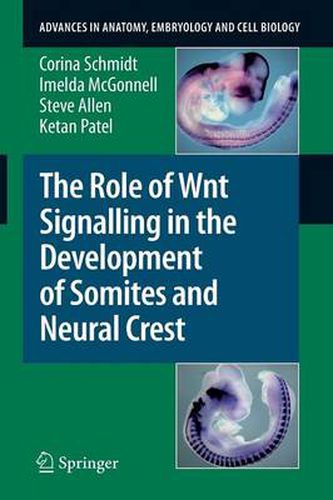Readings Newsletter
Become a Readings Member to make your shopping experience even easier.
Sign in or sign up for free!
You’re not far away from qualifying for FREE standard shipping within Australia
You’ve qualified for FREE standard shipping within Australia
The cart is loading…






This title is printed to order. This book may have been self-published. If so, we cannot guarantee the quality of the content. In the main most books will have gone through the editing process however some may not. We therefore suggest that you be aware of this before ordering this book. If in doubt check either the author or publisher’s details as we are unable to accept any returns unless they are faulty. Please contact us if you have any questions.
1 Introduction 1. 1 Wnts and Development The f amily of Wnt genes consists of at least 19 members in vertebrates. Wnts ha v e multiple roles during normal development and aetiology of diseases (Wodarz and Nusse 1998; Moon et al. 2002, 2004). These genes encode for glycoproteins that are released in the intercellular space, acting as intercellular mediators (Moon et al. 1997). By binding to their special receptors, the Frizzled (Fz) receptors, they are able to activate at least three different pathways: the canonical, the non-canonical and the Ca 2+ pathway (Fig. 1 ). The Wnt family has been subdivided, using functional assays, into at least two subclasses. In Xenopus , Wnt1, Wnt3a and Wnt8 are able to induce axis duplication in embryos, whereas Wnt4, Wnt5a and Wnt11 cannot (Du et al. 1995). Those Wnts that are able to induce axis duplication are thought to act canonically; those who cannot are thought to act non-canonically. In the literature, therefore, some Wnts are called canonical Wnts while others are called n- cano nical Wnts, suggesting that a special Wnt always activates the same signalling pathway. It is unlikely that the specificity dictating cellular responses resides solely in the Wnt ligands because no one has reported sequence or structural motifs in Wnts that predict their activities in these cellular and embryonic assays.
$9.00 standard shipping within Australia
FREE standard shipping within Australia for orders over $100.00
Express & International shipping calculated at checkout
This title is printed to order. This book may have been self-published. If so, we cannot guarantee the quality of the content. In the main most books will have gone through the editing process however some may not. We therefore suggest that you be aware of this before ordering this book. If in doubt check either the author or publisher’s details as we are unable to accept any returns unless they are faulty. Please contact us if you have any questions.
1 Introduction 1. 1 Wnts and Development The f amily of Wnt genes consists of at least 19 members in vertebrates. Wnts ha v e multiple roles during normal development and aetiology of diseases (Wodarz and Nusse 1998; Moon et al. 2002, 2004). These genes encode for glycoproteins that are released in the intercellular space, acting as intercellular mediators (Moon et al. 1997). By binding to their special receptors, the Frizzled (Fz) receptors, they are able to activate at least three different pathways: the canonical, the non-canonical and the Ca 2+ pathway (Fig. 1 ). The Wnt family has been subdivided, using functional assays, into at least two subclasses. In Xenopus , Wnt1, Wnt3a and Wnt8 are able to induce axis duplication in embryos, whereas Wnt4, Wnt5a and Wnt11 cannot (Du et al. 1995). Those Wnts that are able to induce axis duplication are thought to act canonically; those who cannot are thought to act non-canonically. In the literature, therefore, some Wnts are called canonical Wnts while others are called n- cano nical Wnts, suggesting that a special Wnt always activates the same signalling pathway. It is unlikely that the specificity dictating cellular responses resides solely in the Wnt ligands because no one has reported sequence or structural motifs in Wnts that predict their activities in these cellular and embryonic assays.